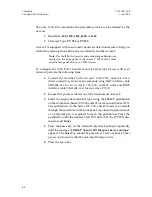
DTE Port Configuration
To configure a DTE port, perform the following steps:
1.
From the Main Menu Line, select
DTE
.
2. Select
PORT1
,
PORT2
,
PORT3
,
or
PORT4
.
3.
With the cursor on
RATE
, specify whether the DTE rate is a multiple
of 56 or 64 kbps. When a rate of Nx56 is selected, bit 8 (the least
significant bit) is always ONE, guaranteeing a pulse density of 1 in 8.
A rate of Nx64 allows clear channel operation; pulse density may be
guaranteed by the DTE, by bit 7 stuffing, by B8ZS encoding, by
alternate-DS0 mapping, or by inversion of HDLC-formatted data.
Press the
Esc
key.
4. Move the selection bar to
CLOCK
and press the
Enter
key. Select a
normal or inverted clock. Press the
Esc
key.
5. Move the selection bar to
DATA
and press the
Enter
key. Select normal
or inverted data. Press the
Esc
key.
6.
Move the selection bar to
INTERFACE
and press the
Enter
key. Specify
the interface type (
V.35
or
RS449
). Select
RS449
for an EIA 530 interface.
Press the
Esc
key.
7.
Move the cursor to
RTS
. If the DTE does not support the RTS hand-
shaking signal, select
PERMANENT
. Otherwise, select
ACTIVE
(RTS con-
trolled by the DTE). Press the
Esc
key.
Note 1:
If the DTE cable is disconnected while
RTS=PERMANENT
, ZEROS may be transmitted in the
DS0s assigned to the DTE port. If the DTE cable is
disconnected while
RTS=ACTIVE
, all ONES will be
transmitted in the DS0s assigned to the DTE port.
Note 2:
If
RTS = PERMANENT
, the Status report will not
reflect RTS loss; however, RTS loss will be registered
in the Alarm History.
8.
Access-T provides a “terminal timing” mode to eliminate the effects of
propagation delays when longer-than-normal cables are used. Ter-
minal timing should be used for cable lengths of from 30 to 200 feet.
In the standard timing mode, data is clocked into the Access-T or DTE
based on clock(s) transmitted by one device or the other. For example,
if the DCE is the clock source, transmit and receive clock from the
Chapter 6
ACST-0351-005
Configuration Procedures
June 1996
6-12






























